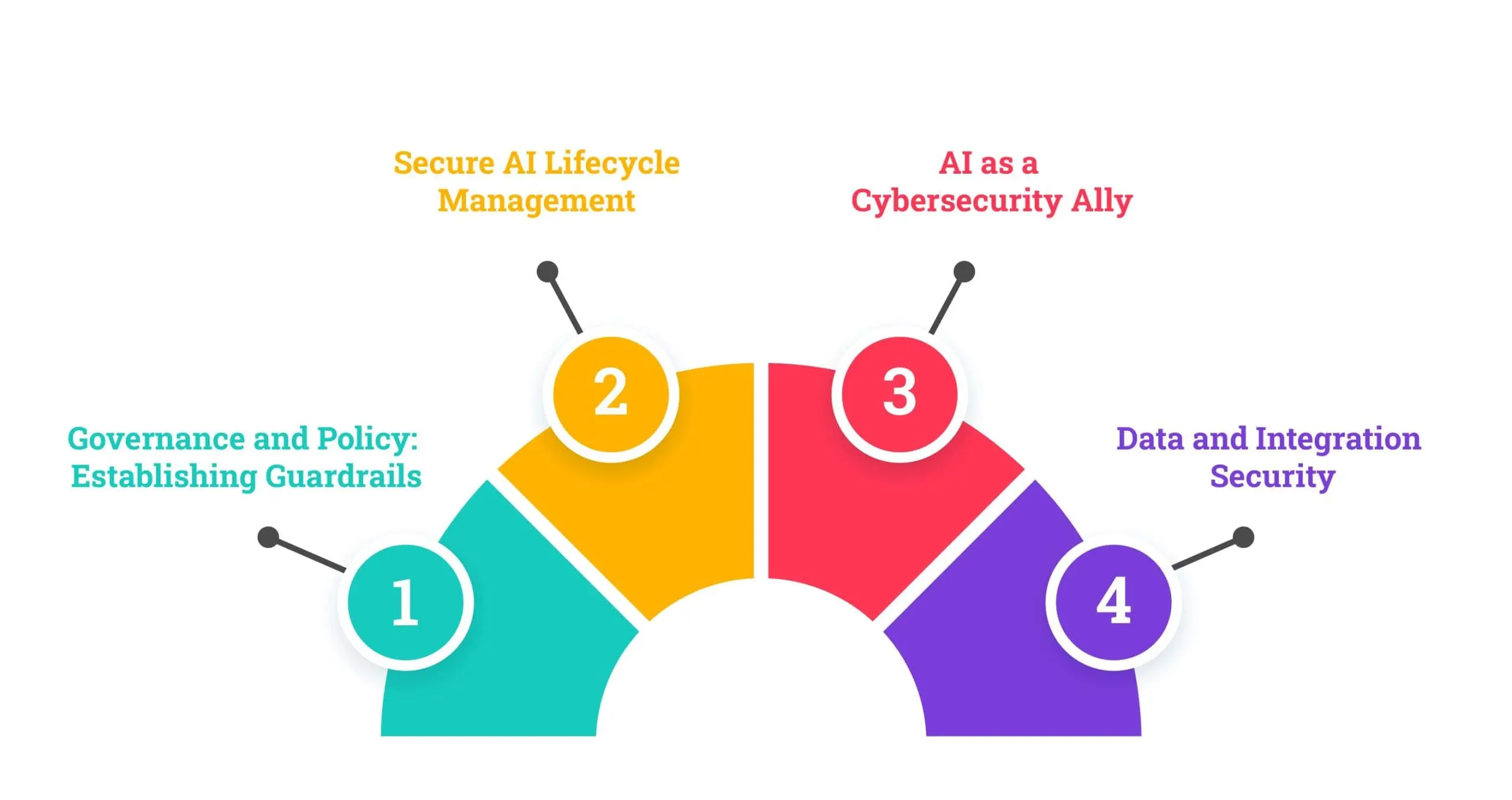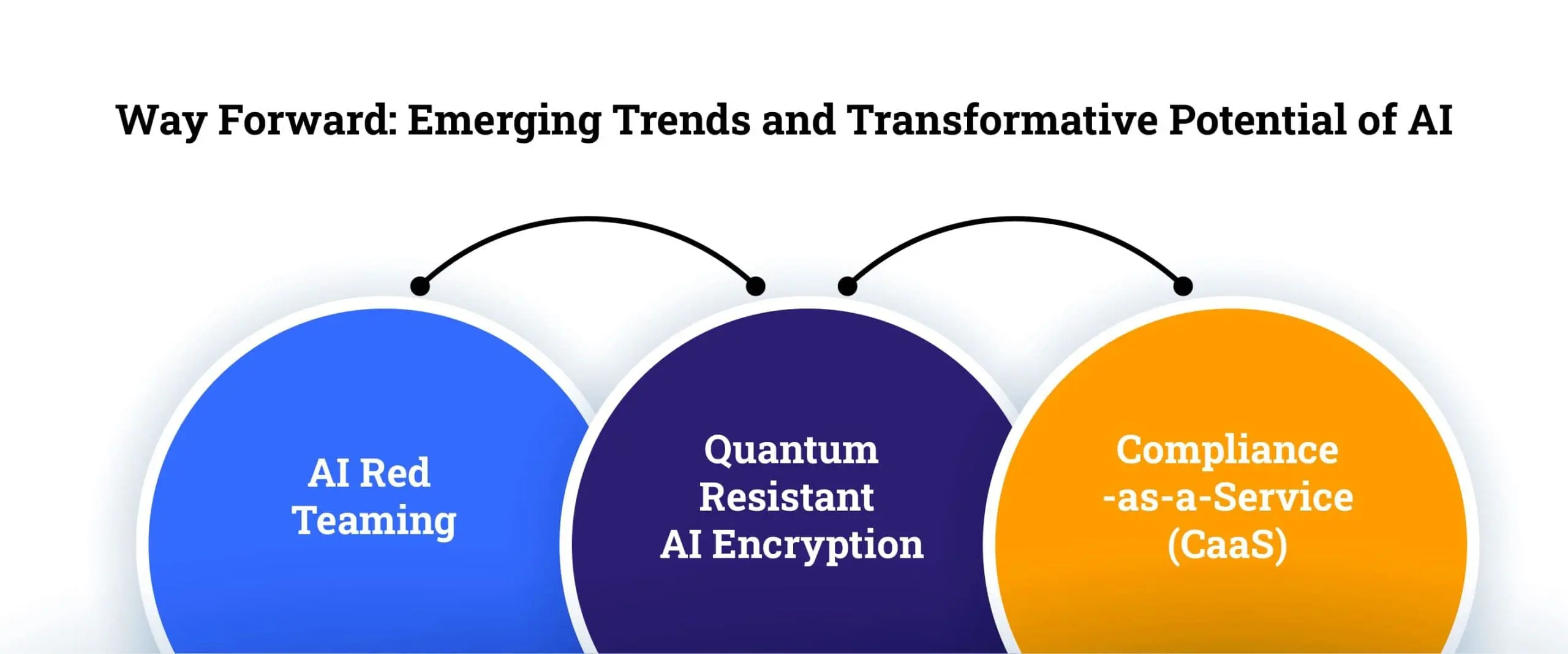Blog
AI with Effective Security for Organizations

Unlocking the Full Potential of AI with Effective Security for Organisations
The UAE and Saudi Arabia are racing ahead with national AI strategies to position themselves as global AI leaders. From Saudi Arabia’s Vision 2030 to the UAE’s National AI Strategy, countries across the region are racing to harness the disruptive power of Artificial Intelligence (AI). Did you know that 70% of firms see AI as critical, but only 14% have scaled its use across all business functions? This is because of poor data, unclear strategy, security concerns, and a lack of skilled talent.
Let us explore how businesses can securely unlock AI’s full potential. From implementation challenges to adversarial threats, we delve into the cybersecurity approaches essential to defending and empowering AI innovation. But before that, let us start with the evolution of AI Integration in Middle Eastern Businesses.
The Evolution of AI Integration in Middle Eastern Businesses
Enterprises leverage AI to streamline operations, enhance decision-making, and drive efficiency through intelligent automation. Government entities use it for urban planning, smart city management, and public service delivery.
However, as AI becomes more deeply embedded in business operations, it introduces unprecedented security challenges. As mentioned earlier, 70% of firms see AI as critical to their success, but only 14% have successfully scaled its use across all business functions. This shows the gap between ambition and execution due to several key challenges. First, many organisations lack a clear, enterprise-wide strategy for AI, leading to siloed pilot projects that don’t scale. Data quality is another major barrier — poor, inconsistent, or siloed data limits the effectiveness of AI models. Security and compliance concerns also play a role, as businesses fear data breaches, AI misuse, and regulatory fallout.
Additionally, there’s a significant skills gap, with many organisations lacking AI-literate leadership and specialised talent. The high cost and complexity of computing infrastructure required to train and run advanced AI models also make scaling a resource-intensive effort.
Regulatory scrutiny is also intensifying. In one landmark case, OpenAI’s ChatGPT was fined for violations of data privacy regulations, highlighting the growing legal exposure businesses face when deploying AI. Governments in the Middle East are still adapting to these rapid changes, often leaving businesses in a regulatory grey zone.
Major AI Cybersecurity Risks
AI brings with it an entirely new attack surface — one that cybercriminals are already exploiting. Gartner’s 2025 predictions make it abundantly clear: we are entering a period of “AI turbulence.” Attack vectors are no longer limited to traditional infrastructure but now include data pipelines, machine learning (ML) models, and AI agents themselves.
1. AI Poisoning Attacks
Perhaps the most insidious of these threats is AI poisoning — manipulating training data to corrupt the model’s outputs. Just as a small amount of poison can ruin an entire well, a subtle but malicious data injection can derail AI outcomes, leading to financial loss, reputational damage, or worse, systemic failure.
2. Model Theft, Inversion, and Extraction
Attackers can reverse-engineer deployed AI models to steal proprietary algorithms or infer sensitive training data. These model extraction and inversion attacks compromise intellectual property and violate privacy regulations.
4. Prompt Injection & Model Evasion
Prompt-based GenAI systems are vulnerable to injection attacks where malicious prompts subvert system integrity. Similarly, model evasion techniques allow adversaries to craft input that bypasses detection mechanisms.
Cybersecurity Framework for Organizational Resilience
Securing AI is not a checklist but a continuous lifecycle discipline that demands a holistic, end-to-end approach. At Paramount, we advocate for an AI cybersecurity framework built on four core pillars:

1. Governance and Policy: Establishing Guardrails
Organisations must lay the foundation with clear, enforceable AI usage policies. This includes guidelines around ethical AI use, privacy adherence, data minimisation, and third-party integrations. Just as traffic rules make highways safer, governance policies guide safe AI operations.
2. Secure AI Lifecycle Management
Security must be embedded throughout the AI lifecycle — from data collection and model training to deployment and decommissioning. For example, rigorous validation should be conducted during training to detect poisoned datasets, while runtime monitoring helps detect anomalies indicative of adversarial inputs.
Think of it like aircraft manufacturing — every nut and bolt is tested before flight, and maintenance continues while airborne. Similarly, AI systems require both pre-launch checks and in-operation scrutiny.
3. AI as a Cybersecurity Ally
The irony is that AI can also be our strongest defense. AI-enabled threat detection tools can sift through terabytes of logs, detect anomalies, and initiate automated responses faster than any human team. In Identity and Access Management (IAM), agentic AI can monitor user behaviour and dynamically adjust access privileges based on risk signals — a level of contextual intelligence that’s critical in today’s hybrid IT environments.
4. Data and Integration Security
As AI systems ingest and share data across environments, the integrity and confidentiality of this data become paramount. Encryption, zero-trust architecture, secure APIs, and integration firewalls are essential to ensuring that data is not leaked, tampered with, or misused. This is especially important in cloud-first or multi-cloud architectures, which are increasingly popular in the Middle East.
By aligning with frameworks like AI TRiSM (Trust, Risk, and Security Management), enterprises can achieve not only technical protection but also operational confidence. Cybersecurity should not be viewed as a cost centre — it is an enabler of AI success

Way Forward: Emerging Trends and Transformative Potential of AI
As we look to the future, several trends are shaping how AI security will evolve. Among them:
- AI Red Teaming: Just as penetration testing identifies vulnerabilities in traditional systems, AI red teaming simulates adversarial attacks to find weaknesses in AI models before attackers do.
- Quantum-Resistant AI Encryption: Preparing for the quantum era, where today’s encryption standards may no longer be viable.
- Compliance-as-a-Service (CaaS): Regulatory frameworks like the EU AI Act and upcoming regional standards in the GCC are making compliance a business imperative. CaaS platforms will help organisations stay audit-ready.
But the key to leveraging these innovations lies in one fundamental principle: requirement-first thinking. Don’t start with tools. Start with business outcomes.
Ask: What do we want AI to do? What risks are we willing to tolerate? What data do we need to protect? A well-defined framework ensures that AI deployments are value-driven, feasible, and secure.
This is especially vital in the Middle East, where economic diversification efforts like Saudi Arabia’s Vision 2030 and the UAE’s digital economy strategy depend heavily on technology adoption. AI has the power to accelerate these visions — but only if trust is maintained through robust cybersecurity practices.
Summing Up
AI’s potential for business transformation is undeniable — from predictive maintenance in oil rigs to smart city planning and hyper-personalised banking. Yet, the same AI systems that bring convenience can be weaponised in the wrong hands. For organisations in the Middle East and beyond, the future lies in pairing innovation with security.
Effective cybersecurity is not a barrier to AI adoption; it is the bedrock upon which successful, sustainable, and ethical AI strategies are built. As we collectively enter this new digital era, let us ensure that the AI systems we deploy are not only intelligent, but also trustworthy and secure.
Because in the race for digital supremacy, it’s not just about who innovates faster — it’s about who secures better.
Recent Posts
- Maximize Cybersecurity with Existing Cloud Investments | Paramount
- Why AI Language Models Matter to Your Business
- How to Detect and Prevent Deepfake Attacks in Cybersecurity
- Cloud and BYOD – Securely Integrating for Business Growth
- Achieving Zero Trust in the Middle East with Endpoint Privilege Management

Protect your online assets from cyber threats with Paramount

Comprehensive cyber security solutions for individuals and businesses

Significantly reduce the risk of cyber threats and ensure a safer digital environment.
